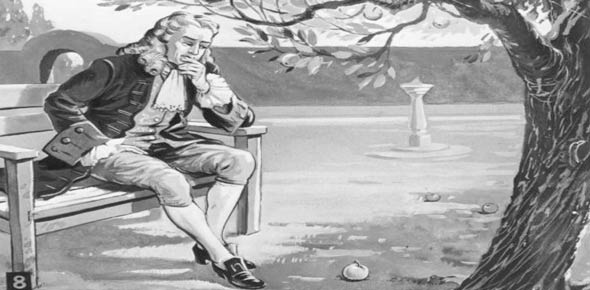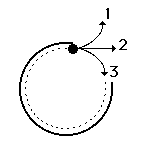Video 1 Newtons First Law Of Motion

- 1.
Imagine a place in the space far from all gravitational and frictional influences. Suppose that you visit that place (just suppose) and throw a rock. The rock will
- A.
Gradually stop.
- B.
Continue in motion in the same direction at constant speed.
- C.
Will not move.
- D.
None of the above.
Correct Answer
B. Continue in motion in the same direction at constant speed.Explanation
According to Newton's first law, the rock will continue in motion in the same direction at constant speed.Rate this question:
-
- 2.
A bowling ball is rolling across the floor with a speed of 4 m/s. How much net force is required to keep the object moving at this speed and in this direction (assume no friction or gravity is present)?
- A.
0 N
- B.
1 N
- C.
10 N
- D.
None of the above.
Correct Answer
A. 0 NExplanation
An object in motion will maintain its state of motion. The presence of an unbalanced force changes the velocity of the object.Rate this question:
-
- 3.
Mac and Tosh are arguing in the cafeteria. Mac says that if he flings the Jell-O with a greater speed it will have a greater inertia. Tosh argues that inertia does not depend upon speed, but rather upon mass. Who do you agree with?
- A.
Mac
- B.
Tosh
- C.
None of the above.
Correct Answer
B. ToshExplanation
Tosh is correct. Inertia is that quantity which depends solely upon mass. The more mass, the more inertia. Momentum is another quantity in Physics which depends on both mass and speed. Momentum will be discussed in a later unit.Rate this question:
-
- 4.
Supposing you were in space in a weightless environment, would it require a force to set an object in motion?
- A.
Yes.
- B.
No.
- C.
None of the above.
Correct Answer
A. Yes.Explanation
Absolutely yes!
Even in space objects have mass. And if they have mass, they have inertia. That is, an object in space resists changes in its state of motion. A force must be applied to set a stationary object in motion. Newton's laws rule - everywhere!Rate this question:
-
- 5.
Fred spends most Sunday afternoons at rest on the sofa, watching pro football games and consuming large quantities of food. If he does this for several months what effect (if any) does this practice have upon his inertia?
- A.
Fred's inertia stays the same!
- B.
Fred's inertia will decrease!
- C.
Fred's inertia will increase!
- D.
None of the above.
Correct Answer
C. Fred's inertia will increase!Explanation
Fred's inertia will increase!
Fred will increase his mass if he makes a habit of this. And if his mass increases, then his inertia increases.Rate this question:
-
- 6.
If the forces acting upon an object are balanced, then the object
- A.
Must not be moving.
- B.
Must be moving with a constant velocity.
- C.
Must not be accelerating.
- D.
None of these.
Correct Answer
C. Must not be accelerating.Explanation
The answer could be A (but does not have to be A) and it could be B (but does not have to be B). An object having balanced forces definitely cannot be accelerating. This means that it could be at rest and staying at rest (one option) or could be in motion at constant velocity (a second option). Either way, it definitely is not accelerating - choice C of your four choices.Rate this question:
-
- 7.
A group of physics teachers is taking some time off for a little putt-putt golf. The 15th hole at the Hole-In-One Putt-Putt Golf Course has a large metal rim that putters must use to guide their ball towards the hole. Mr. S guides a golf ball around the metal rim When the ball leaves the rim, which path (1, 2, or 3) will the golf ball follow?
- A.
1
- B.
2
- C.
3
- D.
None of the above.
Correct Answer
B. 2Explanation
The answer is 2. Once leaving the rim, the ball will follow an "inertial path" (i.e., a straight line). At the instant shown in the diagram, the ball is moving to the right; once leaving the rim, there is no more unbalanced forces to change its state of motion. Paths 1 and 3 both show the ball continually changing its direction once leaving the rim.Rate this question:
-
- 8.
__________ is the tendency of an object to resist changes in its state of motion.
Correct Answer
InertiaExplanation
Inertia is the tendency of an object to resist changes in its state of motion. This means that an object at rest will stay at rest, and an object in motion will continue moving at a constant velocity, unless acted upon by an external force. Inertia is a fundamental property of matter and is related to an object's mass. The greater the mass of an object, the greater its inertia, and the more force is required to change its motion. Inertia is an important concept in physics and helps explain why objects behave the way they do when forces are applied to them.Rate this question:
- 9.
______________ states that "An object at rest stays at rest and an object in motion stays in motion with the same speed and in the same direction unless acted upon by an unbalanced force."
Correct Answer
Newton's First Law of MotionExplanation
Newton's First Law of Motion, also known as the law of inertia, states that an object at rest will remain at rest, and an object in motion will continue moving at a constant velocity in a straight line unless acted upon by an external force. This means that objects tend to maintain their state of motion unless an unbalanced force is applied to change their speed or direction. In other words, if no force is acting on an object, it will either remain at rest or continue moving with the same speed and direction.Rate this question:
- 10.
To determine if the forces acting upon an object are balanced or unbalanced, an analysis must first be conducted to determine what forces are acting upon the object and in what direction.
- A.
True
- B.
False
Correct Answer
A. TrueExplanation
The explanation for the given correct answer is that in order to determine if the forces acting upon an object are balanced or unbalanced, it is necessary to conduct an analysis to identify the forces acting upon the object and their respective directions. This analysis helps to determine whether the forces cancel each other out and result in a balanced situation, or if there is a net force causing an unbalanced situation. Therefore, the statement that an analysis is required to determine the balance or imbalance of forces is true.Rate this question:
-
Quiz Review Timeline +
Our quizzes are rigorously reviewed, monitored and continuously updated by our expert board to maintain accuracy, relevance, and timeliness.
-
Current Version
-
Mar 21, 2023Quiz Edited by
ProProfs Editorial Team -
Apr 02, 2014Quiz Created by
Shane Hancock
 Back to top
Back to top



